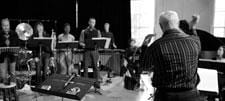Just when you thought you’d seen and heard everything in AIDS-inspired art, the Tapestry theatre company manages to confound clichés and flout convention with a new operatic piece called Dark Star Requiem.
Conceived by composer Andrew Staniland and poet Jill Battson, Dark Star Requiem casts HIV in an unexpectedly sympathetic light. Certainly the disease has been examined, vilified and raged at by countless creators, but Battson’s libretto makes a point of approaching its weighty topic from unexpected angles.
“It’s such a difficult topic that you wonder what there is left to sing about,” says Tapestry music director Wayne Strongman. “When Andrew and Jill first came to us, we didn’t know what to make of it. An evening of poetry doesn’t necessarily suggest a dramatic structure, but this is very affecting and very powerful. I still haven’t figured out how to get through the end of Act One without breaking down.”
“The thing I love about this piece is that Jill anchors this disease by actually giving it a character. Its voice comes through as a lover, making love to the body and creating a relationship that somehow removes some of the fear and pain.”
Utilizing four vocal soloists and featuring the Elmer Iseler Singers, Dark Star Requiem seeks to create a chronological history of AIDS, from its appearance in the early 1980s to present day.
Battson’s poetry casts HIV in a seductive, almost alluring light: Kaposi’s sarcoma becomes an enviable symbol in an aria entitled “Beauty Mark,” while “Black Lion” casts the virus as a powerful beast stalking its prey. The libretto also employs a healthy dose of irreverent humour: the duet “Cocktail” features a couple riffing on antiretroviral drugs and mixed drinks, while bass-baritone Marcus Nance lampoons HIV’s alleged simian origins in a rollicking ditty called “Chimpanzee.”
“It’s just this insane piece,” says Nance. “You end up with such emotion for the chimpanzee. He’s exhausted and ill, but he doesn’t know why. At the same time, he’s trying to evade these hunters who want to eat him. It’s fascinating because Jill and Andrew go so deeply into each element of AIDS and the whole history.”
Battson is aware of the effect her unconventional characterizations of the disease may have on audiences but is prepared for a variety of responses.
“I want people to be able to hear the poems and make their own decisions about them,” she says. “They’ll probably condemn me because I’m the writer, but I’m not consciously making the virus a hero. I’m just taking a different point of view.”
Writing a wide variety of poems for the work represented a personal challenge for the librettist.
“I wanted to write in different voices in different styles,” she says. “I was interested in the idea of African praise poems, which are very prevalent in African culture. They’re shouting, sycophantic pieces that often use animals, as I did in “Black Lion.” The stronger the animal, the more flattering the poem.”
Battson drew upon years of volunteer work in Toronto’s AIDS community in writing the oratorio. She met collaborator Staniland at Tapestry’s 2005 Composer-Librettist Laboratory, an annual 10-day “opera boot camp” that matches composers and writers. Their short opera, Ashlike on the Cradle of the Wind, emerged from that partnership and inspired this current production, which premieres as part of the Luminato Festival.
The production of Dark Star Requiem is the second time that Tapestry has joined with Luminato. Abigail Richardson and Marjorie Chan’s Sanctuary Song premiered at the festival back in 2008, Luminato’s second year, enrapturing audiences of all ages and snagging a Dora Mavor Moore Award for Outstanding New Opera/Musical.
“It’s always a great experience with Luminato,” says Strongman. “I think that any of the theatre companies who partner with them have found that it really serves to expand their reach towards a greater audience.”
Strongman isn’t overly worried that audiences might find the oratorio offensive, having witnessed overwhelming positive reaction to previous workshops of Dark Star.
“People were profoundly moved,” he says. “There was that wonderful prolonged silence when we finished, followed by a wonderful sharing of questions and feedback. It’s another approach to the subject, and the more bridges you give people to it, the more likely they are to take something valuable away from the performance.”

 Why you can trust Xtra
Why you can trust Xtra


